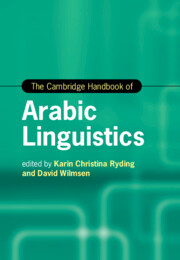Book contents
- The Cambridge Handbook of Arabic Linguistics
- Cambridge Handbooks in Language and Linguistics
- The Cambridge Handbook of Arabic Linguistics
- Copyright page
- Contents
- Figures
- Tables
- Notes on Contributors
- Acknowledgements
- Abbreviations
- Introduction
- Part I Arabic Applied Linguistics
- Part II Arabic Variation and Sociolinguistics
- Part III Theoretical and Descriptive Studies
- Part IV Arabic Computational and Corpus Linguistics
- 18 Arabic Computational Linguistics
- 19 Arabic Corpus Linguistics and Related Tools
- 20 The Utility of Arabic Corpus Linguistics
- Part V Arabic Linguistics and New Media Studies
- Part VI Arabic Linguistics in Literature and Translation
- Index
- References
20 - The Utility of Arabic Corpus Linguistics
from Part IV - Arabic Computational and Corpus Linguistics
Published online by Cambridge University Press: 23 September 2021
- The Cambridge Handbook of Arabic Linguistics
- Cambridge Handbooks in Language and Linguistics
- The Cambridge Handbook of Arabic Linguistics
- Copyright page
- Contents
- Figures
- Tables
- Notes on Contributors
- Acknowledgements
- Abbreviations
- Introduction
- Part I Arabic Applied Linguistics
- Part II Arabic Variation and Sociolinguistics
- Part III Theoretical and Descriptive Studies
- Part IV Arabic Computational and Corpus Linguistics
- 18 Arabic Computational Linguistics
- 19 Arabic Corpus Linguistics and Related Tools
- 20 The Utility of Arabic Corpus Linguistics
- Part V Arabic Linguistics and New Media Studies
- Part VI Arabic Linguistics in Literature and Translation
- Index
- References
Summary
The authors examine the application of electronically searchable corpora, from their own experience, in addressing questions pertinent to linguistics as a whole and to matters internal to Arabic, the while lamenting that the field of Arabic linguistics, in its theoretical and applied orientations alike, has not made use of the rich data source that searchable electronic corpora represent. They show how corpora can be used easily to falsify common assumptions and assertions about the human language capacity in general just as they can be used efficiently to query assumptions and assertions about Arabic itself. So, too, do they hold implications for applied uses such as teaching Arabic as a foreign language and translation between Arabic and other languages. In any of these applications, the use of corpora in the analysis of all varieties of Arabic remains underdeveloped compared to their use in the analysis of other languages, especially English.
Keywords
- Type
- Chapter
- Information
- The Cambridge Handbook of Arabic Linguistics , pp. 473 - 504Publisher: Cambridge University PressPrint publication year: 2021
References
References
Arabic Corpora
Arabic Learner Corpus: http://www.arabiclearnercorpus.com
arabiCorpus: http://arabicorpus.byu.edu
CALM: http://linguistics.byu.edu/thesisdata/CALMcorpusDownload.html
Gumar: https://camel.abudhabi.nyu.edu/gumar/
Korpus Malti http://mlrs.research.um.edu.mt/index.php?page=corpora
shami-corpus: https://github.com/GU-CLASP/shami-corpus
Tunico: https://tunico.acdh.oeaw.ac.at/about_corpus.html
Tunisya: http://www.tunisiya.org
- 2
- Cited by

